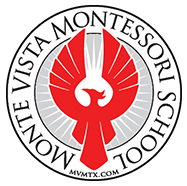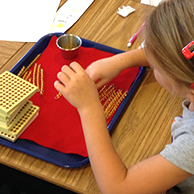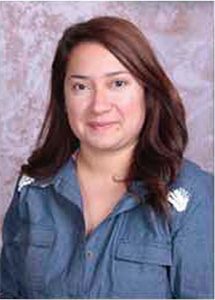By the time primary school children advance to Ms. Kathi’s and Ms. Cindy’s class, they are usually (but not always) old hands at the Montessori Method.
Golden Material
Counting units, tens, and hundreds.
That’s not to say they come home to their parents or guardians talking about child-directed work, mixed-age classes or uninterrupted work periods. Instead, they come home talking about what they decided to work on today, how an older child helped them… or how they helped a younger child.
Ms. Kathi’s and Ms. Cindy’s class is the last stop before the big move upstairs to the upper elementary class so Ms. Kathi, Ms. Cindy, and Ms. Myra observe each child carefully for development of the core competencies he or she will need upstairs.
What does a typical day look like?
Children arrive at school by 8am and have free time to talk and play before lining up to go inside. Children usually start the day with a few minutes of group time. With subjects ranging from reptiles to bone and muscle structure, from human health to intercultural communication, and from geography to volcanoes, group time varies dramatically day-to-day.
The class may read books together or review and discuss concrete examples of the day’s subject. What carries on from day-to-day is an atmosphere of active listening, an adherence to the code of civility established in earlier classes, and an overall expectation of having a really good time at school.
Knowing that the better part of a Montessori day will be devoted to uninterrupted work periods of individual child-directed study, the teachers also take advantage of this brief group time to reinforce structure and set expectations for individual exploration.
How does Montessori accommodate such a wide age range?
Mixed-age classes are a hallmark of a well-run Montessori school. Maria Montessori recognized that different children learn different subjects in different ways. She observed that expecting children to learn at a pace set by the teacher penalizes the students who are further along by holding them back from discovery, and penalizes the students who are just coming up by dragging them forward without understanding. Either way, the child’s inborn passion to explore and learn tends to be extinguished by frustration. In a true Montessori class, each child works at his or her own pace.
With as much as a five-year difference in age and experience, students who are further along are expected to help those who haven’t come as far… and those who need help are expected to ask for it.
The class also uses some structural shorthand to make it easier for each student to work at his or her level. For example, every Monday after group, the entire class does dictionary work. Words on the board are divided into Group 1, Group 2, and Group 3, where Group 1 is the most basic (e.g. cow, wow, bow) and Group 2 and Group 3 are progressively more advanced. This way, more advanced work is always in right in front of the student who is ready for a new challenge.
What about reading, writing, and arithmetic?
Reading & Writing Students continue to build on the foundation started in earlier classes. Maria Montessori observed children learning to read and write in definite stages and developed Montessori Materials to support the natural exploration of each stage.
By the time they reach Ms. Kathi’s and Ms. Cindy’s class, the children have traced sandpaper letter forms, worked with shape tracings to improve hand-eye coordination, and manipulated other materials designed to build strength in their writing hands. Many are budding readers. Students use the moveable alphabet to build “words on the rug” which helps them to learn and remember words while identifying relationships and similarities.
Arithmetic Similarly, students choosing to work on math will work with Montessori Materials like the stamp game, golden material, beads, numbered cards, and more… as well as doing math on paper. Some children gravitate more towards verbal studies, and some are crazy about math.
To fan the flames of their enthusiasm, it’s important to “follow the child” and allow them to work for long, uninterrupted periods on the subjects that hold their attention. Thus, part of the job of the teachers is to monitor each child and gently nudge them towards one or the other if they are reaching the end of a given week short on either side.
How much time do they spend outside?
As much as possible. On most days at 10:45, the students practice Spanish before lining up to go back outside. Physical play is critical to the individual’s physical, mental, and social exploration and development. As in the classroom, outside play is child-directed but monitored and civility and mutual respect is expected. Weather permitting, the children enjoy a half hour of play before sitting down outside to eat lunch at the picnic tables, where socialization continues.
Once the students line up and come back inside, the students are free to continue individual academic work and art. They go back outside at 3:00 and play or visit until they are picked up from school.
When do they do all this singing?
Between The Winter Social, performing at the nursing home, and Brown Bag Day, there is almost always an upcoming concert! A few elementary students from Dr. Hans’s class will often come down with guitars and ukuleles during the last half hour of the day to lead the class in choir practice.
What else does the class do that is different?
Every year, the class tries to attend a Rodeo Day at the San Antonio Stock Show and Rodeo and almost every year a petting zoo visits. The school has also enjoyed visits from Dinosaur George, Last Chance Forever (saving endangered birds of prey), Chicken Dog, the Trinity Players, and more. And of course, we have a great time with every holiday from Halloween, Thanksgiving, Christmas, Chanukah and Kwanza to Valentine’s and the Fourth of July. Near Summer, parents are invited to join students for lunchtime music and recitals at Brown Bag Day.
Ready to learn more? Please arrange with Mr. Andreas to visit the Ms. Kathi’s and Ms. Cindy’s primary class. We look forward to meeting you.
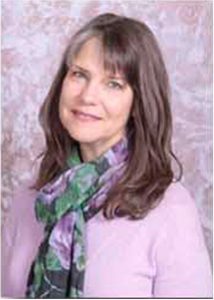
- Primary Students Aged: 6 10
- Team Member Since: 1992
- Montessori Training Completed: 1998
- Quote: We have children of every race, creed, color and political stripe in our class. I can’t help feeling like our little united nations will bring a little more life, liberty and happiness into our world. Ms. Kathi
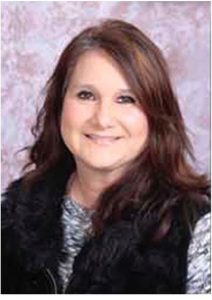
- Primary Students Aged: 6 10
- Team Member Since: 2001
- Montessori Training Completed: 2008
- Quote: Teaching is a beautiful thing, teaching Montessori is even better. It’s amazing to learn things from a child’s mind. Not everyone learns the same and Montessori allows us to focus on the children’s strong suits and interests. We don’t just prepare a child for high school or college, we prepare them for life. – Ms. Cindy
Ms. Myra Martinez, Assistant
- Primary Students Aged: 6-10
- Team Member Since: 2003
- Quote: “Of all things love is the most potent.” – Maria Montessori
